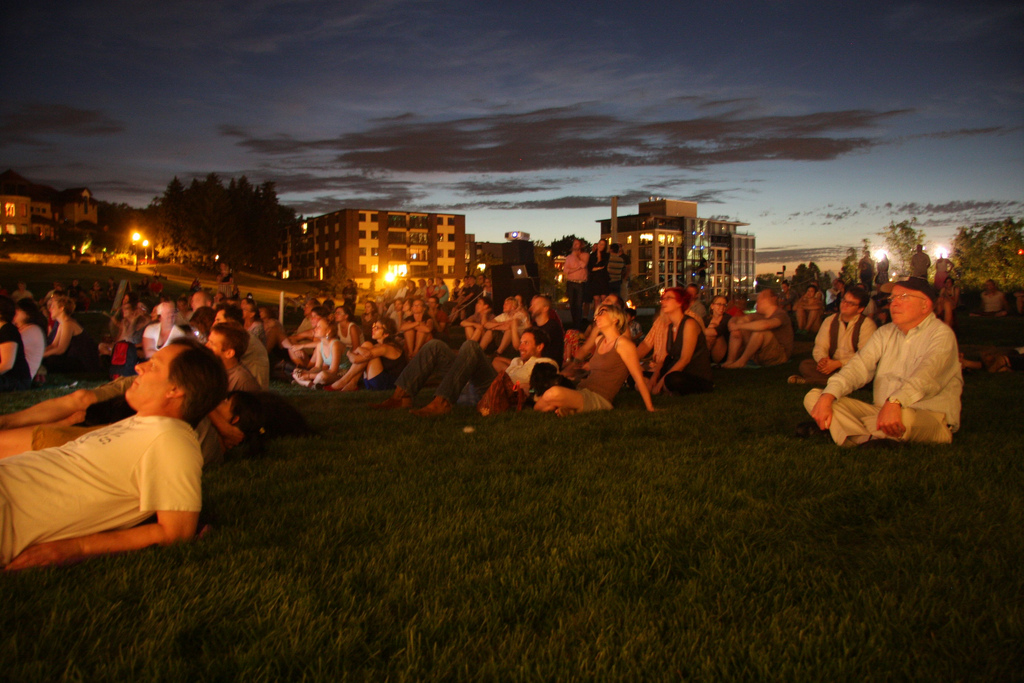Pigeons, Tornadoes, and Technology…Oh My!
I wrote about festival last week that takes advantage of a performing arts center’s outside space for events. The festival is surely one of the more successful ones and a good role model for future, community-based functions. But getting people off the lawn and into the venue itself can be a challenge.
“In our community, we find that sometimes people are afraid to go to an arts event—maybe because it is a new type of event, or maybe they are not sure what to wear,” said Wendy Riggs, director of the Tuscaloosa Amphitheater in Alabama. “We have found that holding an event out in our lawn really breaks the ice for the newcomer to our events, so people get used to the building and to the staff. We market our events inside and have seen a great increase in attendance.”
Riggs, an IAVM member, will facilitate a session titled “Pigeons, Tornadoes, and Technology…Oh My!” at the upcoming Performing Arts Managers Conference (PAMC) in Kansas City, Mo., Feb. 22-25. The session will focus on challenges faced with outdoor events and how you can use them to help patrons “break the wall” and enter a venue. The discussion will center on building new audiences, making good decisions when faced with obstacles, and sharing helpful tools.
One way to encourage patrons to move from outside to inside it to combine events.
“This year, at our seasonal ice rink we decided to combine our event with a ticket that got then skating and sliding outside and to visit our museum exhibit inside,” Riggs said. “We also added our Story Time with Santa inside the museum. The results were that hundreds of people who had never entered the museum crossed our doors this season. We feel we earned a lot of new patrons who will join us for future exhibits and events.”
Riggs’ session is just one of many great educational offerings at this year’s PAMC. Please visit the website for more information and to register.
(photo credit: Machine Project via photopin cc)
Nate Silver’s Super Bowl Weather Forecast
It’s been about 10 minutes since we last spoke about the weather at the Super Bowl, so I figured this video would help satisfy any weather worries you harbor.
In less than two minutes, statistician Nate Silver shows us the percentage of what may happen, such as snow or high winds. All his predictions are based on climatology, the study of weather conditions averaged over a period of time. If Silver is as good at weather prediction as he is at political picks, then be prepared for some high winds at the Super Bowl this year.
Industry News Weekly Roundup
There was a lot of industry news this past week you may have missed. Here are some headlines that caught our eyes.
Stadium Tech Report: DAS, Wi-Fi puts end to no-signal problem at Denver’s Sports Authority Field
—Mobile Sports Report
“When Sports Authority Field is at its listed capacity of 76,125 on game days, it becomes the 14th-largest city in Colorado…”
Australian Open Halted Because of Extreme Heat
—The Weather Channel
“The Extreme Heat Policy was enacted at Melbourne Park just before 2 p.m. Thursday, suspending all matches on outer courts until the early evening and requiring the closure of the retractable roofs at Rod Laver and Hisense arenas before play could continue on the show courts.”
For Senior Leaders, Fit Matters More than Skill
—Harvard Business Review
“A recent CEB survey of C-suite executives indicates that organizations will require significantly higher performance—23% improvement, on average, in performance ratings— from their executive-level direct reports in the new year.”
Sounds of Silence: NYC’s Historic Music Venues Are Becoming History
—New York Observer
“Many New Yorkers will tell you that music spaces have been closing down in the city for decades—the Palladium, Fillmore East and Hippodrome all perished before the turn of the millennium—but never before, it seems, have we seen this kind of widespread, unchecked growth at the expense of so many hallowed venues.”
Two’s Company: Competitive Venues Should be Communicative, Complementary
—The Enid News and Eagle
“How do the two taxpayer-financed venues coexist, and where do they overlap?”
(Image: Mobile Sports Report)
Online Ticket Sales on the Rise for Broadway Shows
Some interesting stats came out of The Broadway League‘s 16th annual demographics report, “The Demographics of the Broadway Audience 2012-2013,” and I thought I’d pass them along to you. The findings pertain to New York, so they may not exactly match your findings in another city, but I think they’re good indicators to keep an eye on.
“The 2012 – 2013 season attracted the largest number of admissions by visitors from other countries since this study has begun, with international tourists accounting for 23 percent of all admissions to Broadway shows in New York City,” said Charlotte St. Martin, executive director of The Broadway League. “We also saw a notable increase in the diversity of our audiences. In particular, we have seen a growth in the Hispanic audience to nearly 8 percent of our theater-going audience. We will continue our efforts to diversify the audience with programs like Viva Broadway, which was initiated two years ago. This season also attracted the largest number of theater-goers age 18-24, and we are hopeful that this trend will continue and these young adults will continue to attend theatre as they age and introduce the theatre-going tradition to their own families.”
The findings include
- 66 percent of tickets purchased were by tourists
- Average theatre attendee age was 42.5 years old
- 78 percent of theatre attendees were Caucasian
- 68 percent of guests were female
- 41 percent purchased their tickets online
The Internet and technology was a topic that came out when we asked members for their 2014 industry predictions for the Dec/Jan issue of FM magazine.
“More social media technology will be permitted at traditional (e.g., symphonies, ballets, operas, Broadway) performing arts events to increase immediate personal interaction, response, and recommendation of the live experience, which helps to promote ticket sales to a ‘non-traditional,’ younger ticket buyer,” said Michael S. Taormina, CFE, managing director of the Cobby Energy Performing Arts Centre. “Also, more venue managers will (should) increase their social media presence as it becomes an important function of their job duties, as well as, develop innovative smart phone applications that promote the convenience, ownership and fun of attending PAC events.”
Speaking of performing arts centers, there’s still time to register for the Performing Arts Mangers Conference, Feb. 22-25, in Kansas City, Mo.
Are you seeing an increase in online ticket sales? How are you using social media to market your venue? Please let us know in the comments section.
The Internet Cat Video Festival is as Cool as It Sounds
Let’s talk about cats on the Internet. It’s a day that ends in “y” so why not.
In 2012, the world’s first Internet Cat Video Festival was held at the Walker Art Center in Minneapolis, Minn. More than 10,000 people gathered to watch videos that are easily found for free online.
“In fact, it was this desire for community engagement that led to the event’s inception as part of a program at the Walker Art Center called Open Field,” Anna Weltner wrote in New Times. “Curated by [Scott] Stulen, the program turns the Walker’s lawn into a community gathering space over the summer, with opportunities to share skills, enjoy music and poetry, participate in activities hosted by artists in residence, and simply hang out. One of the activities Stulen and one of his interns thought of was a crowd-sourced festival of cat videos. An announcement for the event, Stulen said, went viral in two hours. He was shocked when, instead of the predicted 100-or-so viewers, thousands of cat video enthusiasts turned up on the Walker’s lawn.”
Perhaps you already knew about this festival; however, I’m just now hearing about it and I’m interested. The first event was so successful that it now goes on tour, visiting venues in several U.S. cities.
“The current Internet Cat Video Festival tour includes 20 cities, and Stulen has done his best to tailor each event to the city it’s in,” Weltner wrote. “This often includes work with local animal nonprofits, and invitations to local artists to discuss related projects. Ironic as it sounds, the goal of the Internet Cat Video Festival is to foster community.
“‘I think there’s really something different about content we experience online when you take it into a social setting,'” Weltner continues, quoting Stulen. “‘There’s something that people really respond to about watching this stuff together.'”
This a great example of why live experiences will never die. Sure, there’s the fear that people would rather stay at home than attend a live event, and yes, you’re going to have homebodies that want that. But for the most part, people want to be around other people, whether to laugh or cry or cheer, because we’re social creatures. By attending a live event, we meet others that are similar to ourselves, liking the same things we like. By attending a live event, we reassure ourselves that we’re not alone.
The Internet Cat Video Festival stops in Austin, Minneapolis, Oakland, and Portland (home to this year’s VenueConnect) in 2014. Go for the cats. Stay for the people.
(If you’re curious, that is one of my cats, Sailor, in the photo, taken by T. Cole Rachel.)
Do you want to receive a Front Row News weekly digest?
Categories
- Allied (861)
- Architecture (147)
- Arenas (750)
- Career (897)
- Convention Centers (897)
- Education (623)
- Events (1,544)
- Food & Beverage (193)
- Foundation (113)
- Guest Experience (1,497)
- Industry News (2,270)
- Leadership (1,888)
- Marketing (150)
- Membership (2,001)
- Music (213)
- Performing Arts Centers (456)
- Professional Development (409)
- Research (128)
- Safety & Security (442)
- Sports (764)
- Stadiums (611)
- Student (159)
- Technology (516)
- Ticketing (92)
- Touring (82)
- Trends (365)
- Uncategorized (697)
- Universities (218)
- Video (25)
- Young Professional (198)
Twitter Feed
- Twitter feed loading
Recent Posts
- Simpleview Welcomes Industry Veteran, Evelyn Ingram, to Newly Created Venue Digital Strategy Role
- ‘Another One’ for Nicholas Family of Companies: Firm to Break Ground on Elk Grove Ice Arena in Suburban Chicago
- Venue Sustainalytics Launches Website for First-Ever Sustainability Benchmarking Platform for Event Venues
- Maverik Center Names Jeff Davis, CVE, CVP, CMP, as New General Manager
- McAllen and Hidalgo Promoter Joe Vera III, CFEE, CECD, Among Those We Will Miss
Categories
- Allied
- Architecture
- Arenas
- Career
- Convention Centers
- Education
- Events
- Food & Beverage
- Foundation
- Guest Experience
- Industry News
- Leadership
- Marketing
- Membership
- Music
- Performing Arts Centers
- Professional Development
- Research
- Safety & Security
- Sports
- Stadiums
- Student
- Technology
- Ticketing
- Touring
- Trends
- Uncategorized
- Universities
- Video
- Young Professional
Archives
- August 2025
- July 2025
- June 2025
- May 2025
- April 2025
- March 2025
- February 2025
- January 2025
- December 2024
- November 2024
- October 2024
- September 2024
- August 2024
- July 2024
- June 2024
- May 2024
- April 2024
- March 2024
- February 2024
- January 2024
- December 2023
- November 2023
- October 2023
- September 2023
- August 2023
- July 2023
- June 2023
- May 2023
- April 2023
- March 2023
- February 2023
- January 2023
- December 2022
- November 2022
- October 2022
- September 2022
- August 2022
- July 2022
- June 2022
- May 2022
- April 2022
- March 2022
- February 2022
- January 2022
- December 2021
- November 2021
- October 2021
- September 2021
- August 2021
- July 2021
- June 2021
- May 2021
- April 2021
- March 2021
- February 2021
- January 2021
- December 2020
- November 2020
- October 2020
- September 2020
- August 2020
- July 2020
- June 2020
- May 2020
- April 2020
- March 2020
- February 2020
- January 2020
- December 2019
- November 2019
- October 2019
- September 2019
- August 2019
- July 2019
- June 2019
- May 2019
- April 2019
- March 2019
- February 2019
- January 2019
- December 2018
- November 2018
- October 2018
- September 2018
- August 2018
- July 2018
- June 2018
- May 2018
- April 2018
- March 2018
- February 2018
- January 2018
- December 2017
- November 2017
- October 2017
- September 2017
- August 2017
- July 2017
- June 2017
- May 2017
- April 2017
- March 2017
- February 2017
- January 2017
- December 2016
- November 2016
- October 2016
- September 2016
- August 2016
- July 2016
- June 2016
- May 2016
- April 2016
- March 2016
- February 2016
- January 2016
- December 2015
- November 2015
- October 2015
- September 2015
- August 2015
- July 2015
- June 2015
- May 2015
- April 2015
- March 2015
- February 2015
- January 2015
- December 2014
- November 2014
- October 2014
- September 2014
- August 2014
- July 2014
- June 2014
- May 2014
- April 2014
- March 2014
- February 2014
- January 2014
- December 2013
- November 2013
- October 2013
- September 2013
- August 2013
- July 2013
- June 2013
- May 2013
- April 2013
- March 2013
- February 2013
- January 2013
- May 2012
- March 2012
- December 2011
- November 2011
- October 2011
Recent Comments
- Frank Bradshaw, Ph.D., CVE on John Meyer, CVE, a Tireless Advocate of Certification for Venue Professionals, Has Died
- Neil Sulkes on Hilary Hartung, Friend to Many in Venue Marketing, Has Left Us
- Jason Parker, CVE on The Devastation of Hurricane Helene and How We Can Support One Another
- Larry Perkins on Touhey Testifies Against Speculative Ticketing Before Congressional Subcommittee
- Peter Secord on Major Players for Planned Elkhart Amphitheater Were in the Mix at VenueConnect




